Up for review today is a true "dual commemorative" -- the commemorative half-dollar marking the dual sesquicentennial of the Battle of Bennington and Vermont's independence as a republic. The coin is represented by an example in PCGS MS-65.
Considering the number of statehood anniversaries marked by classic commemorative coins, some collectors might assume that the present coin marks the 150th anniversary of Vermont's admission into the Union as its 14th state. In actuality, the anniversary being celebrated is Vermont's own January 1777 declaration of independence from claims by New York and New Hampshire over its territory. It was originally called the "Republic of New Connecticut" but its name was changed to "Vermont" in June of the same year.
Read More: Commems CollectionIra Allen (brother of Ethan) was a member of the Green Mountain Boys, a group of soldiers from Vermont originally formed to fight New York's claims on Vermont, but later a group that fought against the British for the independence of the American Colonies. Ira became a key force behind Vermont becoming a state -- Vermont became the 14th state in 1791 -- and is often considered the "Founder of Vermont."
In 1777, the British had a plan to separate the New England colonies from the more southern colonies. In an attempt to achieve this, British General John Burgoyne began a campaign from Canada through the Lake Champlain area with Albany, New York as his target. The plan saw some initial success -- Burgoyne took Fort Ticonderoga in July -- but Burgoyne's forces were in desperate need of supplies by August. So, he sent a force of approximately 800 Hessian and Native American troops to Bennington, Vermont to obtain the needed provisions as well as wagons and horses -- the British had reports that Bennington was being used as a supply depot by the Americans. Thinking the town was only lightly defended, the British were surprised when they encountered heavy resistance from the Vermont and New Hampshire militia -- including the Green Mountain Boys -- as they approached. The Americans emerged victorious with less than 30 casualties, while the British suffered over 200 casualties and had roughly 600 troops captured. The Battle of Bennington is considered one of the turning points in the Revolutionary War for the Americans. One note on the battle, while the storehouse of supplies may have been in Bennington, Vermont, the battle actually occurred approximately 10 miles to the west in New York.
As with many of our commemorative coins, the designs for the Vermont half-dollar did not follow a straight path from initial concept to struck coin. Initially, the Vermont Sesqui-Centennial Commission decided upon a portrait of Ira Allen for the obverse and a depiction of the Battle of Bennington Monument for the reverse. The Commission contracted with artist Sherry Fry of New York to prepare the models. The models were not viewed favorably by the Commission of Fine Arts (CFA) who, among other issues, opposed the use of the Bennington Monument on the reverse. It's interesting (and comical) to note that there appears to have been some confusion during the CFA review, with the monument erroneously believed to be one marking a battle of the War of 1812!
Fry, an artist of note, was very displeased with the reaction to his models and ultimately decided that he would rather remove himself from the project than bow to the pressure of the CFA to make significant changes. So, the Vermont Sesqui-Centennial Commission began a search for a new artist and selected Charles Keck, who had previously designed the 1915 Panama-Pacific Exposition gold dollar and the 1936 Lynchburg Sesquicentennial half-dollar.
Keck soon provided a new set of models for review. The CFA was fine with Keck's obverse depiction of Ira Allen (with suggestions for simplifying the inscriptions used), but once again was not pleased with the reverse. Keck had replaced the Bennington Monument with a depiction of Fay's House which later became the Catamount Tavern (after a stuffed catamount was mounted on the tavern's signpost). In general, the CFA was not in favor of any architectural rendering on the coin, stating that such depictions were more appropriate for medallions.
The Vermont Commission argued that the site was a historically important meeting place in early Vermont, especially for the Green Mountain Boys, and that it was the place where John Stark of the GMBs planned for the Battle of Bennington (among other battles). Looking to not prolong the "battle" with the CFA, however, the Vermont Sesqui-Centennial Commission acquiesced and agreed to all coin design guidance from the CFA.
The CFA recommended use of a catamount, believing it would be much more amenable to superior artistic rendering. It should be noted that the CFA and the Mint wanted very much to create a coin of very high design quality owing to the fact that it was for Vermont and Vermont native Calvin Coolidge was in the White House as our 30th president. Keck prepared three new models for the reverse (two with a catamount) with the left facing catamount seen on the coin being the one accepted.
The coin shown is a nicely lustrous example with just the lightest partial golden toning, most visible on the reverse (unfortunately seen as tan in my scans). I find Keck's designs to be very nicely done -- bold but not overpowering.
The coins were sold for $1.00 in person and $1.25 via the mail, and were distributed in one-coin cardboard holders as shown below.
The Vermont Sesqui-Centennial Commission issued a final report on the celebrations. I've included images of the Title page and the two pages that discussed the half-dollar.
I've also included an image of the cover from the "Official Programme" from the centennial celebration of Vermont's statehood, it shows the Bennington Monument which was erected to honor its namesake battle.
Enjoy!
1927 Vermont Independence / Battle of Bennington Sesquicentennial -- Obverse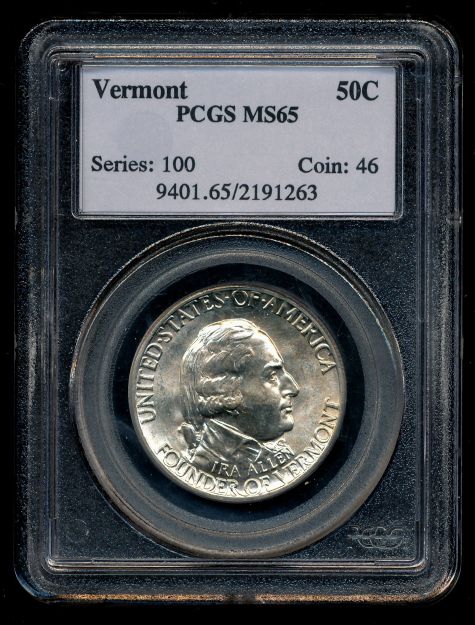 1927 Vermont Independence / Battle of Bennington Sesquicentennial -- Reverse
1927 Vermont Independence / Battle of Bennington Sesquicentennial -- Reverse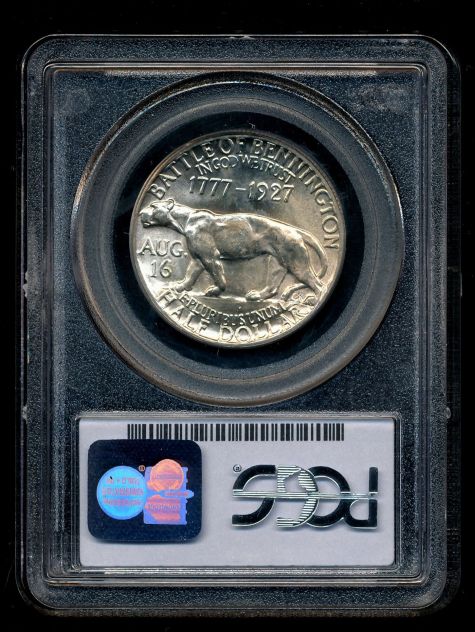 Original Coin Holder/Mailer -- Front
Original Coin Holder/Mailer -- Front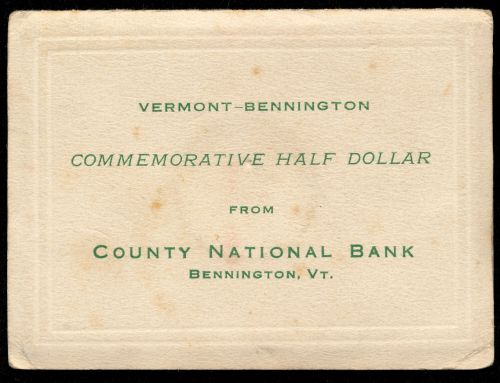 Original Coin Holder/Mailer -- Interior
Original Coin Holder/Mailer -- Interior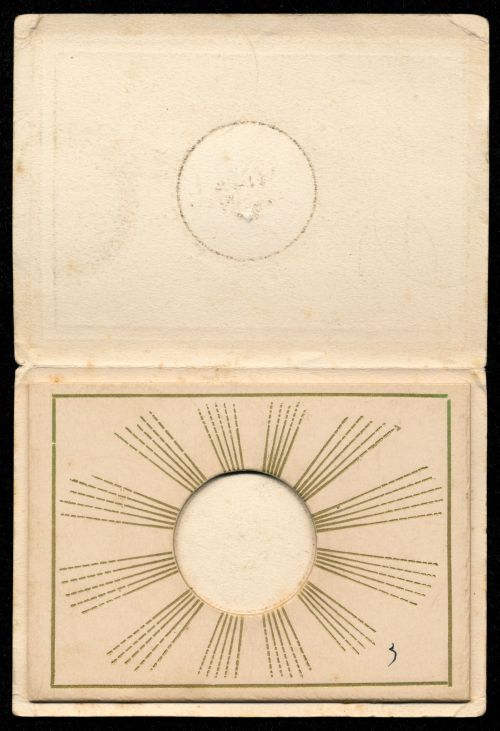 Vermont Sesqui-Centennial Commission Report -- Title Page
Vermont Sesqui-Centennial Commission Report -- Title Page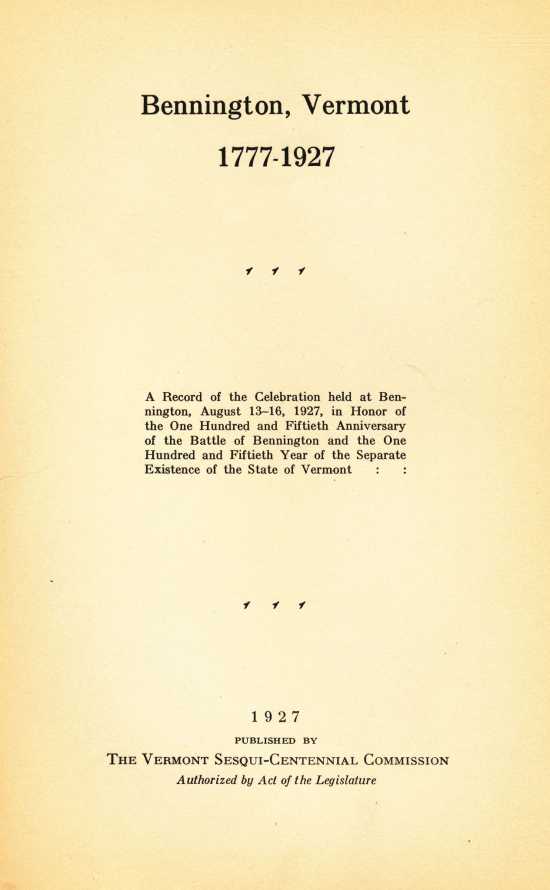 Vermont Sesqui-Centennial Commission Report -- Commem Coin Page 1
Vermont Sesqui-Centennial Commission Report -- Commem Coin Page 1 Vermont Sesqui-Centennial Commission Report -- Commem Coin Page 2
Vermont Sesqui-Centennial Commission Report -- Commem Coin Page 2 1891 Vermont Statehood Centennial Programme -- Front Cover
1891 Vermont Statehood Centennial Programme -- Front Cover





























